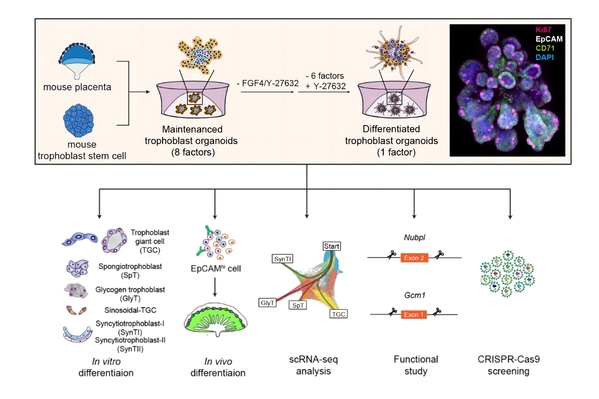Through a 100-million-year evolution and adaptation, the eutherian placentae has become one ofthe most morphologically variable organs. Besides the fetal-maternal exchange, recent studies in mouse models have demonstrated that developmental defects in placentae could exert pronounced effects on embryo growth and development, leading to the necessity for high-throughput screens on modulators for mouse trophoblast development. Nonetheless, in vitro studies of those trophoblast subtypes arechallenging, given that mouse trophoblast stem cells are highly prone to differentiating into ectoplacental cone-derived lineages andthe limited directed differentiation protocols for specific trophoblastsin the two-dimensional condition. Furthermore, progenitor/precursor subpopulations were not yet identified or characterizedin the current 2D differentiation protocols.
Recently, groups led by Assistant Professor Lin Chao-Po and Associate Professor Wang Haopeng in SLST, have, for the first time, established mouse trophoblast organoids derived from mouse trophoblast stem cells or placentae, and highly recapitulated the developmental features of trophoblast lineages in mouse placentae in vitro. In this work, two culture conditions were developed for the study of mouse trophoblast organoids: the maintenance condition, in which trophoblast organoids are highly enriched with stem/progenitor cells; and the differentiation condition, in which trophoblast organoids contain differentiated trophoblastsubtypes that are hard to be retrieved under the 2D condition (i.e., the chorial lineages). The similarity between trophoblast organoids and placental trophoblasts was further validated by multiple analyses, including chimeric assay, immunostaining, in situ hybridization, and single-cell RNA-sequencing, while potential regulators and/or cell-cell communications were also revealed. Together,this murine trophoblast organoid model could serve as a platformfor studies on rare trophoblast stem cells/progenitors as well as for the CRISPR/Cas9 high-throughput screening.

On December 5, the two groups’ work was published in Developmental Cell in an article entitled “Murine Trophoblast Organoids as a Model for Trophoblast Development and CRISPR-Cas9 Screening”. PhD students Mao Qian and Ye Qinying, master’s graduate Xu Yuwen, and Postdoctoral Fellow Jiang Jingwei are the co-first authors of the paper. Prof. Lin and Prof. Wang are the corresponding authors.
*This article is provided by Prof. Lin Chao-Po

